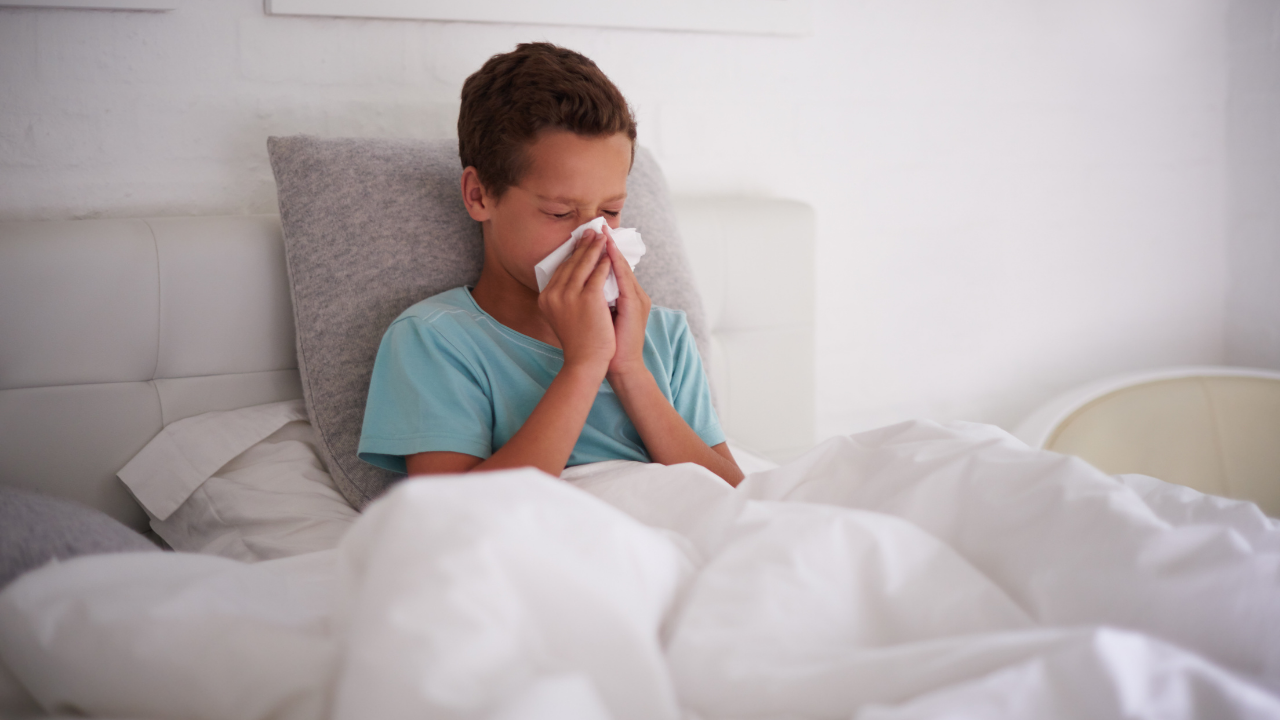Your child has an eczema diagnosis; now what?
It can be disconcerting to discover that your child has eczema, also known as atopic dermatitis, but it's more common than you might suspect. Atopic dermatitis affects over 13% of all children under 18 in the United States and typically appears for the first time between six months and five years old.
The American Academy of Pediatricians (AAP) reports that 65% of children with eczema develop symptoms before the age of one. Given how common baby eczema is and how early it can affect your child, we've created this guide to help you recognize, understand and manage your child’s eczema.
1. Atopic Dermatitis Causes
The National Eczema Association defines atopic dermatitis as “a chronic, inflammatory condition that results from an overactive immune system response to triggers inside and outside the body.”
If you're wondering if eczema is contagious, it's not. No one can pass eczema to your baby, and your baby cannot pass it to anyone through physical touch.
Researchers have yet to determine what causes eczema, but they do know it's a combination of genetic and environmental factors. This means baby eczema tends to run in families with a history of eczema, as well as with related conditions or hay fever, asthma, and other allergies.
For children with mild or severe eczema, one of two things happens: their skin is allergic to something in the environment due to their genetic predisposition, or their skin doesn’t have a sufficient natural moisture barrier to hold essential moisture in and thus dries out. Either situation results in red, itchy, inflamed skin that is susceptible to infection and can recur often if not adequately managed.
2. Environmental Triggers

Whether allergies or a compromised skin barrier cause your child’s eczema, specific triggers result in what we call an eczema flare-up. This is when the skin is actively inflamed and itchy; the rest of the time, your child will not have any visible rash.
If your baby has eczema, the first goal is determining which triggers affect them. Just as adults are allergic or bothered by different skin irritants, so are children. However, children often have different triggers, and as they grow, those triggers may change.
Common eczema triggers include harsh or scented soaps, extreme temperatures, pollen, pet dander, food allergies, sweat, and dry air. Through careful observation and trial-and-error, you can learn your child’s triggers and then avoid those triggers to help prevent eczema flares.
3. Atopic Dermatitis Symptoms
Eczema flares most often cause red, dry, inflamed patches of skin - which tend to itch - a lot! Itchiness is a particular symptom of eczema, which we’ll discuss in the next section.
Other eczema symptoms vary in location, appearance, and severity as children age:
- 0-6 months: Red, weepy patches on cheeks, chin, forehead, and scalp
- 6-12 months: Rash on knees and elbows, which are more prone to infection as a baby crawls
- 1-5 years: Dry, scaly, and thick patches with deep lines running throughout on creases of knees and elbows, as well as wrists, hands, and ankles
- Five years and older: Red, itchy patches on hands or creases of knees and elbows
Learn more about the symptoms of eczema in our article on symptoms and treatment.
Managing atopic eczema symptoms
Upon noticing your baby's eczema symptoms, it's important to treat the affected areas immediately to avoid further skin damage. We recommend moisturizing your baby’s skin with dye-free, fragrance-free creams daily. Consistency is key, and frequent moisturizing is often better! In general, we recommend creams over lotions, as lotions tend to be more drying. Using wet wraps over the affected areas to keep skin hydrated and reduce itching can also be helpful.
Additionally, we recommend avoiding additives, chemicals, detergents, drying sheets, dyes, fragrances, or any other irritants that may worsen your baby's eczema symptoms. Consult with a pediatrician or pediatric dermatologist to determine the best treatment for your child.
4. Managing Itchiness

One of the primary symptoms of a baby eczema rash is itchiness. You may find your baby rubbing the affected area on carpet, bedding or continuously scratching to get some relief.
Unfortunately, scratching makes the rash itchier and can lead to skin infections. Decreasing the inflammation of your baby’s skin will help reduce the itchiness.
Some ways to reduce scratching and provide relief for your baby's itchy skin are:
- Keep baby’s nails well trimmed
- Use cotton mittens at bedtime to prevent scratching while sleeping
- Apply cold compresses to affected areas
- Bathe daily with mild dye- and fragrance-free soap, pat skin dry and moisturize immediately after
- Dress them in loose-fitting clothes to prevent further irritation
More ideas to prevent your child from scratching itchy skin
Another way we recommend providing relief for an itchy rash: distraction! You can try reading stories, singing songs, or playing peek-a-boo; the laughs, cuddles, and quality time can help take their mind off of the itch. The best part? This method can work for babies, toddlers, and older children.
<div fs-richtext-component="cta" class="content_cta">
<div class="content-cta__title">
<div class="y-tex-xxs text-color-white">
Blueberry - Rated best for online pediatrics!
</div>
</div>
<div class="y-text-2xl text-color-white">
👩🏽⚕️ Chat With A Pediatrician About Your Child's Symptoms
</div>
<a href="https://app.blueberrypediatrics.com/join_blueberry_18a_cart?promo=blog100"
target="_blank" class="content-cta_btn w-button">
Get Started
</a>
<link rel="prefetch" href="https://app.blueberrypediatrics.com/join_blueberry_18a_cart?promo=blog100">
5. Eczema and Skin Infections
Even if you do safeguard your baby from itching, infection is still a possibility. Skin affected by eczema tends to be dry and can crack, allowing bacteria, viruses, and other germs to get in.
It can sometimes be challenging to distinguish a normal eczema flare-up from one with a secondary infection. Here are some signs to help you recognize an infection:
- The usual treatments don't work, and your baby's eczema stays the same or worsens
- Yellow, orange, or honey-colored crusting, blisters, sores, or even streaks of redness
- Fever or flu-like symptoms
If your child develops flu-like symptoms with a fever over 100.4, seek immediate medical attention. If you suspect an infection, make an appointment with your baby’s physician so the area can be assessed and properly treated. Your physician may prescribe an oral antibiotic, antiviral medication, or anti-fungal ointment.
6. Caring for Your Baby's Sensitive Skin

The goal is to reduce and prevent flare-ups in your child's body. Doing so helps prevent everything we've discussed: symptoms, itchiness, and potential infection.
There are two ways to help avoid eczema flare-ups: 1) Identify and limit contact with known triggers, and 2) Implement a daily skincare routine to help prevent dry skin and maintain a moisture barrier against irritants and allergens. A daily skin routine is important to maintain - even if no rash is visible.
Tips for bathing and moisturizing children prone to baby eczema
- Use a mild, fragrance-free cleanser and lukewarm water
- Avoid bubble baths and average no more than a 15-minute soak during bath time
- Rinse baby's skin thoroughly and pat dry after bathing
- Apply fragrance-free moisturizers or ointments (petroleum jelly products are best) to damp skin
- Moisturize face and entire body - including the diaper area - twice a day
Consult the American Academy of Dermatologists (AAD)'s online Eczema Resource Center to find easy-to-reference guides on how to bathe your child, and select and apply a moisturizer.
7. Treating Your Baby's Skin
While preventing contact with triggers and maintaining a daily skincare routine will go a long way in helping manage your child’s eczema, additional treatment may be necessary.
There are many prescription and over-the-counter medicines available to manage eczema. We recommend consulting with your child’s physician before choosing a treatment. Your pediatrician will help identify the best medicine, cream, or ointment specific to your child’s needs based on their specific symptoms.
Additionally, your pediatrician may recommend oral antihistamines and/or topical steroids to help reduce inflammation and relieve itching. Many parents are interested in natural remedies. Like over-the-counter treatments, it’s important to check with your child’s physician before starting any treatment, as children may have allergic reactions or serious side effects from natural products and herbal remedies.
8. Food Allergies and Baby Eczema
The relationship between atopic dermatitis and food is complicated. Children with food allergies may or may not have eczema, and children with eczema may or may not have other allergies (to food, environmental triggers, or asthma). A food allergy on its own will show the following symptoms soon after your child eats or touches certain foods:
- Flushed, red skin or hives
- Itching on the inside of the mouth
- Swollen face, lips, or tongue
- Vomiting and/or diarrhea
- Stomach cramps
- Dizziness or lightheadedness
- Difficulty breathing
If your child does have a food allergy as well as baby eczema, the next step is to determine if that food allergy causes an eczema flare-up or not.
The most common foods linked to baby eczema are cow’s milk, eggs, peanuts, and soybeans. That said, the Journal of American Academy of Pediatrics states that more than 90% of parents “incorrectly believe that food allergy is the sole or main cause of their child’s skin disease.”
The only way to know if a specific food causes an eczema flare-up is to do a “challenge” test. Always consult a doctor before conducting a “challenge” test.
9. Other Skin Conditions

Although atopic dermatitis is the most common skin condition to affect children, it is far from the only one. Many other rashes can affect your baby and are often mistaken for baby eczema, such as baby acne, milia, cradle cap (also known as seborrheic dermatitis), and heat rash. Like eczema, these conditions can affect various areas of the skin, including your baby's cheeks, ears, armpits, and diaper area, and may also appear in the newborn phase.
Remember, the most distinguishing characteristic of baby eczema, compared to the other aforementioned rashes, is that eczema will always be itchy. To learn more about these other skin conditions, please read our article, Baby Eczema vs. Other Skin Conditions, and consult the Baby Center for a visual guide of all the conditions described.
10. Doctor Supervision
Eczema is a chronic condition that may affect the quality of your child's life. As such, regular visits with your child’s pediatrician are important and recommended. Your child’s doctor will closely monitor for any changes in skin condition and adjust treatment when needed.
Most parents will become adept at managing their child’s eczema and preventing flare-ups. However, your child may experience severe symptoms that require immediate attention. You can prepare for these occurrences by joining Blueberry Pediatrics.
Blueberry offers text, phone, or video care from board-certified pediatricians 24/7. The best part? An entire year of Blueberry membership costs less than the typical copay of a single urgent care visit, and one membership covers all children in your household - it's like having a doctor's office in your home! Sign up here.
.png)
Sources:
- Update on Atopic Dermatitis: Diagnosis, Severity Assessment, and Treatment Selection, The Journal of Allergy and Clinical Immunology: In Practice
- Eczema in Babies and Children, HealthyChildren.org
- Causes, symptoms, treatment and more, National Eczema Association
- Eczema Resource Center, American Academy of Dermatology Association
- Atopic Dermatitis: Skin-Directed Management, Journal of American Academy of Pediatrics
- What Do Patients and Caregivers Need to Know about Oral Food Challenges?, American Academy of Allergies Asthma & Immunology
- Visual guide to children's rashes and skin conditions, BabyCenter.com






.svg)






.svg)
.svg)